Abstract
Detailed investigations are carried out on the biological effects of heated effluents on a system of five interconnected lakes in central Poland which are used as circulating cooling system for two base-load thermopower stations. The eutrophication has been turned into valuable fish production through a combination of increased growth rates and introduction of eel, common carp, and Chinese carps. Thanks to the strict biological management, no adverse growth of aquatic plants or plankton has occurred, the latter being of vital importance for the operation of the power stations.
Résumé
Des investigations détaillées ont été faites sur les effets biologiques des effluents réchauffés dans un système de cinq lacs interconnectés en Pologne centrale, utilisés comme refroidisseurs pour deux stations thermiques à système continue. L'eutrophisation a été utilisé pour la production substantielle de poisson par la combination de l'augmentation des taux de croissance et l'introduction d'anguille, carpes commune et chinoises. Grâce à la stricte exploitation biologique on n'a observé aucune augmentation de plantes aquatiques ou de plancton, ce dernier facteur ayant une importance vitale pour le bon fonctionnement des stations therniques.
The Konin Project in Central Poland is an outstanding example of an integrated approach for utilization of cooling waters. The Project consists of two base-load thermopower stations discharging cooling water at 80 m3 per second with a temperature varying from 10.1 to 35.0°C into a system of five interconnected lakes in series with a total area of 1 100 ha. The cooling water for the stations is withdrawn from the end of the same lake system. The aim of the research project sponsored by the Council for Mutual Economic Assistance (CMEA) is to prevent harmful effects to the thermopower stations and to the environment by use of biological control methods. The research work has been carried out since 1958 by the Inland Fisheries Institute, Olsztyn-Kortowo. Since 1965 monthly samples have been taken of water, benthos, plankton and fish.
In 1958 the first thermopower station was put into operation and the cooling water was taken from Patnow Lake and discharged into Lichen Lake through open channels (Fig.3). Comparative investigations were initiated of several parameters in heated and unheated lakes in the same system. In the spring of 1968 heated water was discharged for the first time also into Mikorzyn Lake through a channel which can be closed with a gate. The direct discharge into this lake is done as an extraordinary measure. In 1969 the second power station was started. This station takes its cooling water from Gosław Lake and discharges it into the existing channel leading into Lichen Lake.
The cooling system is operated differently in winter and summer. In summer all five lakes are involved and the output of the power stations is slightly decreased. Water is then pumped in a channel from Lichen Lake into Ślesin Lake with a maximum flow of 40 m3 per second. In winter the pumping station is not operated and the water flows from Licheń Lake into Patnow Lake only and subsequently into Gosław Lake. The lake system is situated at the upper end of a drainage basin and the natural flow of water is negligible compared to the induced flows.
2.1.1 Thermal conditions
The differences in temperature and the yearly changes during the period 1965–1970 for surface and bottom layers in the most heated and in one unheated lake are shown in Fig.4. The greatest difference in surface temperature occurs during December to April, reaching about 13°C. In summer the maximum difference is 9°C. The temperatures of the bottom waters differ much more - the differences in summer being about 20°C and in winter about 9°C.
The two deepest lakes, Ślesin and Mikorzyn, have a marked stratification whereas Lichen Lake is only stratified in its deepest parts and the two shallow lakes, Gosław and Patnow, are completely mixed.
The summer stratification in Licheń Lake begins at the end of April and ends at the end of September, while in unheated lakes the stratification lasts from the middle of April to the middle of November.
The Polish Meteorological Institute carries out daily measurements of air and surface water temperatures in the Konin area. High temperatures are observed throughout the year in Lichen Lake; in winter there is a complete lack of ice cover and a partial lack of ice cover on Gosław and Patnow Lakes.
The lack of ice cover in the heated lakes has changed some fishing operations; for example, bream was previously caught in winter by nets under the ice, a rather difficult operation which restricted the catches.
The evaporation from the surface of the heated lake is double that of the unheated lakes (Chojnowski, 1970).
2.1.2 Oxygen content
Oxygen content and temperature were investigated simultaneously and it was found that the heating has no influence on the oxygen content or on the saturation of oxygen. In the surface layers of the most heated lake (Licheń), the oxygen content never falls below 6 mg/l throughout the year. Since the lake is rather shallow (average depth 5 m) the oxygen content at the bottom does not fall below 1 mg/l. The thermoclines as well as the oxygen gradients of the unheated lakes are more pronounced than in the heated lakes and the oxygen content decreases rapidly at the depth of 5–7 m. This is also due to the fact that the unheated lakes are deeper. The decrease in oxygen content of the water before and after passing through the thermopower stations does not exceed 2.4 mg/l in summer and winter, and 0.6 mg/l in spring and autumn.
Very little change due to the heating has been observed in the chemistry of the water in the lakes. The general tendency was a slight enrichment of the water but this was probably due to effluents from a coal mine situated near Lichen Lake (Korychka, 1970)
2.3.1 Primary production, phytoplankton
Primary production has been investigated over a seven-year period and detailed investigations were carried out during the four-year period, 1966–1969. During the warmest period of 1966 very detailed measurements were carried out at two-day intervals on the most heated (Lichen) and one unheated lake (Mikorzyn). These results gave a basis for comparison of further data. The average primary production of Lichen Lake (temperature 26°–28.5°C) was 7.0 g of oxygen per m2 per day, and for Mikorzyn Lake it was 3.8 g of oxygen per m2/day, viz. primary production was increased 100 percent in the heated lake. It was clearly seen from the data obtained that primary production of Lichen Lake is very high, being in the range of production of very highly eutrophic lakes. The transparency of water in Lichen Lake was, however, equal or only slightly smaller than in unheated lakes. The high production in Lichen Lake is caused mostly by the more rapid turnover, depending directly on the temperature, while biomass of phytoplankton is only slightly higher than in unheated lakes. The species diversity of phytoplankton increases with temperature (Fig.5) and no dominant species develop.
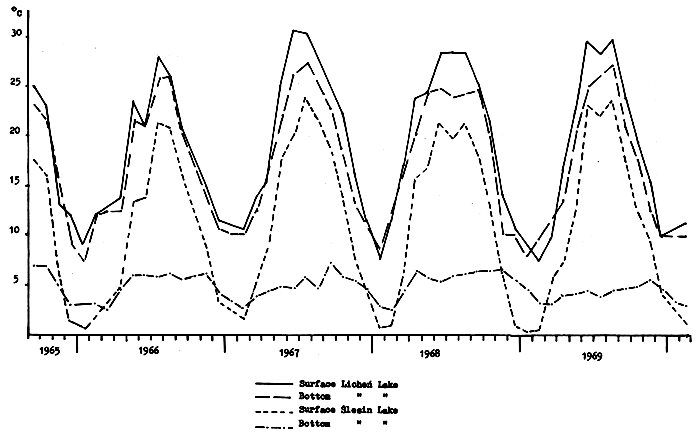
Fig.4 Water temperatures 1965–1969
The values obtained in the following years confirm the result of the intensive investigation from 1966. Detailed calculation of the production factors show that in Lichen Lake there are still some reserves of production which are not at present utilized by higher trophic levels (Patalas, 1967, 1970; Półtoracka-Sosnowska, 1967).
2.3.2 Zooplankton
Detailed investigations during the period 1965–1970 gave the following summary results:
In summer the production of zooplankton in Lichen Lake was twice as big (13.18 g/m2/ day) as in unheated lakes (7.20 g/m2/day). At the same time the production of phytophagous zooplankton was four times greater in the heated (3.9 g/m2/day), than in the unheated lake (0.9 g/m2/day). The daily turnover varied in Licheń Lake for different species from 0.14 to 0.40. The rise of temperature by about 6°C doubles the production of zooplankton due to quicker turnover while the biomass of zooplankton remains constant. The production of predatory forms of zooplankton is slightly lowered by the temperature increase. The ratio between the production of plant-eating forms and primary production considered as the index of ecological productivity is 0.11 in the unheated lake and 0.13 in the heated lake. Thus Lichen Lake may be considered as a very productive reservoir. The heating of a lake not only raises the production but also raises the rate of energy flow from one trophic level into another (Patalas, 1967, 1970).
It was found that in the heated lake Daphnia cucullata had a 20 percent greater body length than in lakes with normal temperature and its rate of growth was 40 percent higher as compared with its rate of growth in the same lake eight years ago.
2.3.3 Bottom fauna
Investigations showed that the biomass of bottom fauna was slightly lower in the heated lake and that the species composition was not changed. Instead of the normal two maxima per year, only one maximum appears in the heated lake but the reason for this is not clearly understood.
2.3.4 Fish
Before the start of the thermopower plants the lake system had a fish fauna typical for the region and unaffected by pollution. The fishery on the lakes has for a long time been carried out by state fisheries and detailed records of catches of different species have been kept since 1955.
This has given much valuable background information for investigation of changes in the fish population. The changes are due both to the heating of the lakes (Licheń and Patnow from 1958, Mikorzyn from spring 1968, and Ślesin and Gosław from 1969), and to introduction of new fish species.
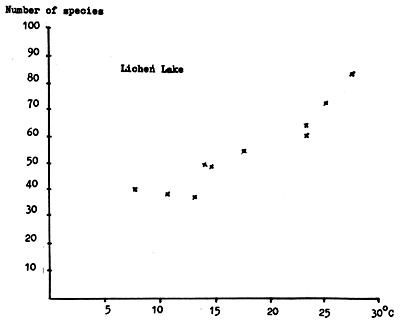

Fig. 5 Phytoplankton (except diatoms)
Lethal temperature: Detailed investigations of lethal temperatures for fourteen species in Lichen Lake undertaken by Dr. L. Horoszewiez (which will be published in 1971) show that after three generations in heated water the fish does not show any inherited adaptation to higher lethal temperatures. The lethal temperature was found to be specific for each species and the results are in agreement with the results of Alabaster and Downing (1966) who found a linear correlation between lethal and acclimatization temperatures.
Growth rate: The rate of growth has increased for all fish species (Fig.6). For pike-perch (Lucioperca lucioperca) the rate of growth is similar to that found in warm climates; rudd (Scardinus erythrophthalmus) has a growth rate previously found only in the Aral Sea; roach (Rutilus rutilus) has the highest growth rate found anywhere in Poland (Marciak, 1970; Wilkońska, 1970; Źuromska, 1970). The rapid growth rate seems to be accompanied by a shorter life span of fish compared with unheated lakes. The growth of fish fry is very rapid compared to unheated lakes (Fig. 7).
The age determination of fish by scale reading was found to be more complicated in heated waters since the scale rings do not develop in the normal manner and therefore new techniques for scale reading has been developed for the four most important species: pike-perch, rudd, roach and bream (Abramis brama).
Fertility: The heating has changed the fertility of some fish species, in that for some species an increase has occurred while for others the fertility decreased.
Detailed investigations of 23 species of fish fry in Lichen Lake was undertaken in 1966–1969 by Źuromska and Wilkońska (1970). Newly-hatched fry was found already in the beginning of April and all species of fish had intermittent spawnings from April to the end of June. Concentration of newly-hatched fry appeared in May–June and by the end of September the small fishes moved from the shore into the centre of the lake.
Fish parasites and diseases: The question of parasites and diseases has so far not been thoroughly investigated but the data obtained show a striking correlation between elevated temperature and increase in infestation. This is to a large extent due to physical factors; up to 90 percent of the bream was found infested with tapeworm Ligula, because birds acting as intermediate hosts for the tapeworm assemble in great numbers on the ice-free lakes in winter. The rapid growth of bream in the first three years is thereafter retarded due to the tapeworm infestation and the infested bream is also not accepted by the consumers. Blindness of perch and pike-perch due to metacercaria was also found to be correlated to water temperature. Fish fry were found to be affected by protozoa to an unusually high extent. Generally it seems that the heating of lakes increases the problems of fish parasites, partly offsetting the beneficial effects of increased temperatures.
Behaviour: The increase in temperature induced some changes in behaviour of fish. For example, it was found that eel (Anguilla anguilla) [introduced], does not spread into adjoining lakes but stays in the most heated lake. A detailed investigation was done on the migration of bream between the different lakes in the system. 1 000 bream were tagged and released in each lake. Bream released in the unheated lake (Ślesin) migrated into the heated lake (Licheń) and remained there, whereas bream released in the heated lake migrated into the unheated lake during summer but returned to the heated lake in winter (Frieske, 1970).
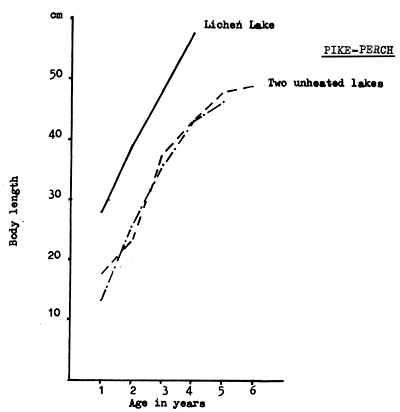
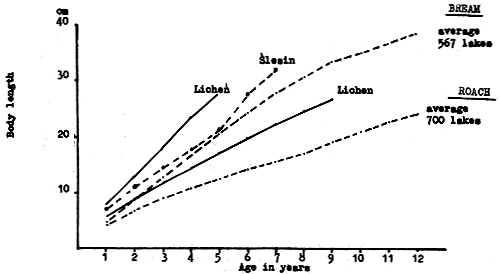
Fig.6 Growth of fish
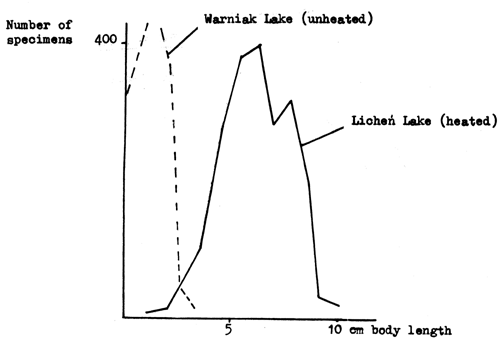 | Fig.7 Body length of roach fry |
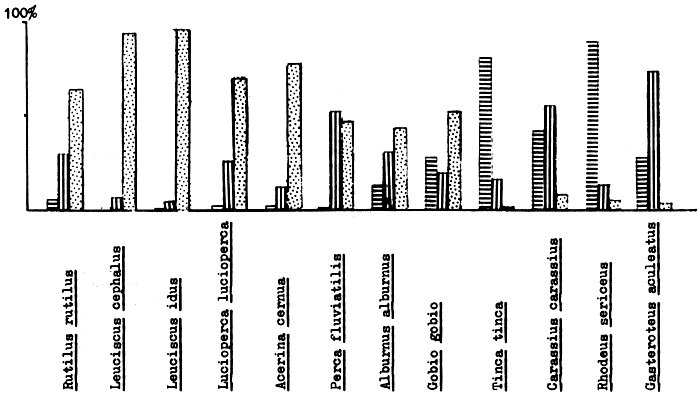
Fig.8 Comparison of catches (including fry) by species in 1966, 1967 and 1968. (Note 100% equals total catch of one species in these three years)
3.1.1 Species introduced
The heating of the lakes increased the productivity and the investigations at an early stage indicated the necessity of introduction of new fish species, in order to avoid unwanted eutrophication effects (especially high content of organic matter affecting the cooling system of the thermopower stations) and to obtain maximum beneficial effects. Eels were bought from France and introduced to utilize the bottom fauna. As previously mentioned, eels do not spread from Lichen Lake. Carp (Cyprinus carpio) was introduced to utilize the bottom fauna and activate the bottom sediments. Grass carp (Ctenopharyngodon idella) was introduced to control the growth of aquatic plants. Bighead carp (Aristichthys nobilis) and silver carp (Hypophthalmichthys molitrix) were introduced to utilize and control the increased production of phytoplankton. Fry of the Chinese carps were obtained in 1964 from a Soviet hatchery and kept in the ponds at Zabieniec. In 1966, 500 kg of the two-year-old fish (average weight 0.8 – 1 kg) was introduced into Lichen Lake. The growth rate of the introduced fish was very high. After one year the average weight was 3.5 kg and thereafter the increase in weight has been about 3 kg per year. The introduced warmwater fish have remained in the heated lakes and not spread into the unheated lakes.
3.1.2 Results of introductions
The objectives of the introductions have been fulfilled. The macrophytes in the heated lakes are controlled by the grass carp to such an extent that those fish species laying eggs on plants [tench (Tinca tinca), crucian carp (Carassius carassius) and stickle-back (Gasteroteus aculeatus)] have shown a decrease while other fish species proliferated also after the introduction (Fig.8). The plankton is utilized so that the transparency of the water has not decreased and the thermopower stations have had no problems with organic matter in the cooling water systems.
The heated effluents are also used for a fish culture station where the first stocking took place in 1968. The construction works were completed in 1970 and from this station it is expected to obtain 30 million fry per year of phytophagous fish. (The fish culture station has been described separately 1).
1 Thorslund, A., Thermopower effluents for fish culture in Poland. Vatten (1):36–9, 1972
One of the main objectives of the research work was to establish standards for the effluents from the thermopower stations. As the chemical composition of the water was not affected the only standard required was for maximum temperature. The thermopower plants are operating continuously; therefore it was not felt necessary to establish standards for variation of temperature. In order to maintain the diversified biological system necessary both for the fishery and for the cooling system of the power plants the maximum permissible temperature in the most heated lake shall not exceed 28.5°C. In emergency situations the temperature may, in summer, be increased to 31.0°C for the duration of one week.
The area around the lakes is scarcely inhabitated and no significant organic wastes are discharged into the lakes. No discharges of organic matter will be permitted in the future.
All the research work described above is continuing in order to follow up the situation and if necessary bring forward corrective measures.
The operation of the thermopower stations has run according to plans and no emergency situation has developed. The only problem encountered is that great fish losses occur at the pumping station pumping 40 m3 per second from Licheń into Ślesin Lake during summer. This problem is being further investigated.
The success of the Konin Project clearly demonstrates that the so-called thermal pollution problem can in fact be converted into a valuable natural resource. When the common interests of the thermopower authorities and the fishery authorities are recognized it is possible to obtain a cooperation from which both parties benefit. In the Konin Project this was realized from the very beginning and the positive results obtained will be utilized for future thermopower stations, the next project commencing in 1972. It is expected that cooling water from future thermopower stations in Poland will not be discharged to rivers or to coastal waters but utilized in lakes with biological control methods as in Konin. The magnitude of future undertakings is illustrated by the following: in the next ten years the discharge of cooling water in Poland is expected to increase from presently 200 to 700 m3 per second and 10 000 ha of lakes will be utilized for cooling purposes.
Alabaster, J.S. and A.L. Downing, 1966 A field and laboratory investigation of the effect of heated effluents on fish. Fishery Invest., Lond. (1), 6(4):42 p.
Chojnowski, S., 1967 Wyniki badań stosunków termicznych w jeziorach ślesińskich. [The results of investigations of thermal conditions in Ślesin Lake.] Summary report on 7th Polish Hydrobiologists Congress in Świnoujście, September 1967.
Chojnowski, S., 1970 Wpływ zanieczyszczeń termicznych na stosunki termiczne jezior konińskich. [The effect of heated effluents on the thermal conditions in Konin Lake.] Summary report on 8th Polish Hydrobiologists Congress in Białystok, September 1970
ECE, 1969 Problems in the design and operation of thermal power stations. ST/ECE/EP/23 Vol.IX, New York 1969
Frieske, Z., 1970 Wpływ ciepłych wód na uźytkowośc rybacką jezior rejonu Koninskiege. [The effect of heated waters on the fishery management in the Konin Lake system.] Olsztyn-Kortowo 1970.
Horoszewicz, L., 1970 Temperatury letalnie niektórych gatunków ryb. [,Lethal temperatures for some Polish fish.] Summary report on 8th Polish Hydrobiologists Congress in Białystok, September 1970
Korychka, A., 1970 Badania chemiczne wody jezior konińskich w latach 1965–1967. [Chemical investigations of Konin Lakes 1965–2967.] Summary Report on 8th Polish Hydrobiologists Congress in Białystok, September 1970.
Marciak, Z., 1970 Wpływ podgrzania wody w jeziorach konińskich na wzrost leszcsa i struktur jego łusek. [The effect of heated effluents on the growth of bream in the
Konin Lakes, and on the structure of scales.] Summary Report on 8th Polish
Hydrobiologists Congress in Białystok, September 1970.
jego łusek. [The effect of heated effluents on the growth of bream in the
Konin Lakes, and on the structure of scales.] Summary Report on 8th Polish
Hydrobiologists Congress in Białystok, September 1970.
Patalas, K., 1967 Produkoja pierwotna i wtórna planktonu w jeziorze ogrzewanym przez elektrowni cieplnạ. [Primary and secondary production of plankton in lake heated by electricity
power plant.] Summary report on 7th Polish Hydrobiologists Congress
in Świnoujscie, September 1967
cieplnạ. [Primary and secondary production of plankton in lake heated by electricity
power plant.] Summary report on 7th Polish Hydrobiologists Congress
in Świnoujscie, September 1967
Patalas, K., 1970 Proceedings of 1970 Annual Technical Meeting of the Institute of Environmental Science, Boston
Półtoracka-Sosnowska, J., 1967 Skład gatunkowy fitoplanktonu w jeziorach o temperaturze sztucznie podwyźszonej i normalnej. [Composition by species of phytoplankton in lakes with normal and artificially raised temperatures.] Summary Report on 7th Polish Hydrobiologists Congress in Świnoujście, September 1967
Wilkońska, H., 1970 Wzrost płoci (Rutilus rutilus L.) w sztucznie podgrazanym jeziorze Licheń. [Rate of growth of roach in artificially heated Lichen Lake.] Summary Report on 8th Polish Hydrobiologists Congress in Białystok, September 1970.
Źuromska, H., 1970 Wzrost wzdr gi (Scardinius erythrophthalmus L.) w jeziorach sztucznie
podgrzewanych. [The rate of growth of rudd in artificially heated lakes.]
Summary Report on 8th Polish Hydrobiologists Congress in Białystok,
September 1970
gi (Scardinius erythrophthalmus L.) w jeziorach sztucznie
podgrzewanych. [The rate of growth of rudd in artificially heated lakes.]
Summary Report on 8th Polish Hydrobiologists Congress in Białystok,
September 1970
Źuromska, H. and H. Wilkońska, 1970 Skład gatunkowy narybku i drobnych ryb w litoralu jeziora sztucznie podgrazanego. [The species composition of fish fry and small fishes in the littoral of artificially heated lakes.] Summary report on 8th Polish Hydrobiologists Congress in Białystok, September 1970